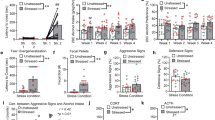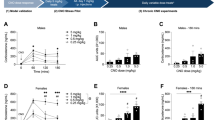Abstract
The global crisis of opioid overdose fatalities has led to an urgent search to discover the neurobiological mechanisms of opioid use disorder (OUD). A driving force for OUD is the dysphoric and emotionally painful state (hyperkatifeia) that is produced during acute and protracted opioid withdrawal. Here, we explored a mechanistic role for extrahypothalamic stress systems in driving opioid addiction. We found that glucocorticoid receptor (GR) antagonism with mifepristone reduced opioid addiction-like behaviors in rats and zebrafish of both sexes and decreased the firing of corticotropin-releasing factor neurons in the rat amygdala (i.e., a marker of brain stress system activation). In support of the hypothesized role of glucocorticoid transcriptional regulation of extrahypothalamic GRs in addiction-like behavior, an intra-amygdala infusion of an antisense oligonucleotide that blocked GR transcriptional activity reduced addiction-like behaviors. Finally, we identified transcriptional adaptations of GR signaling in the amygdala of humans with OUD. Thus, GRs, their coregulators, and downstream systems may represent viable therapeutic targets to treat the “stress side” of OUD.
This is a preview of subscription content, access via your institution
Access options
Subscribe to this journal
Receive 12 print issues and online access
$259.00 per year
only $21.58 per issue
Buy this article
- Purchase on Springer Link
- Instant access to full article PDF
Prices may be subject to local taxes which are calculated during checkout






Similar content being viewed by others
References
Strang J, Volkow ND, Degenhardt L, Hickman M, Johnson K, Koob GF, et al. Opioid use disorder. Nat Rev Dis Prim. 2020;6:3.
Understanding the Epidemic | Drug Overdose | CDC Injury Center. 2019. Accessed 7 January 2020 https://www.cdc.gov/drugoverdose/epidemic/index.html.
Case A, Deaton A. Rising morbidity and mortality in midlife among white non-Hispanic Americans in the 21st century. Proc Natl Acad Sci USA. 2015;112:15078–83.
Koob GF. Neurobiology of opioid addiction: opponent process, hyperkatifeia, and negative reinforcement. Biol Psychiatry. 2020;87:44–53.
Evans CJ, Cahill CM, Neurobiology of opioid dependence in creating addiction vulnerability. F1000Res. 2016;5:F1000 Faculty Rev-1748.
Mechling AE, Arefin T, Lee H-L, Bienert T, Reisert M, Ben Hamida S, et al. Deletion of the mu opioid receptor gene in mice reshapes the reward-aversion connectome. Proc Natl Acad Sci USA. 2016;113:11603–8.
Pantazis CB, Gonzalez LA, Tunstall BJ, Carmack SA, Koob GF, Vendruscolo LF. Cues conditioned to withdrawal and negative reinforcement: Neglected but key motivational elements driving opioid addiction. Sci Adv. 2021;7:eabf0364.
Koob G, Kreek MJ. Stress, dysregulation of drug reward pathways, and the transition to drug dependence. Am J Psychiatry. 2007;164:1149–59.
Koob GF, Schulkin J. Addiction and stress: an allostatic view. Neurosci Biobehav Rev. 2019;106:245–62.
McEwen BS, Akil H. Revisiting the stress concept: implications for affective disorders. J Neurosci. 2020;40:12–21.
Selye H. Stress and the general adaptation syndrome. Br Med J. 1950;1:1383–92.
Schulkin J, The CRF signal: uncovering an information molecule. Oxford University Press; 2017.
de Kloet ER, Meijer OC, de Nicola AF, de Rijk RH, Joëls M. Importance of the brain corticosteroid receptor balance in metaplasticity, cognitive performance and neuro-inflammation. Front Neuroendocrinol. 2018;49:124–45.
Carmack SA, Keeley RJ, Vendruscolo JCM, Lowery-Gionta EG, Lu H, Koob GF, et al. Heroin addiction engages negative emotional learning brain circuits in rats. J Clin Invest. 2019;129:2480–4.
Upadhyay J, Maleki N, Potter J, Elman I, Rudrauf D, Knudsen J, et al. Alterations in brain structure and functional connectivity in prescription opioid-dependent patients. Brain. 2010;133:2098–114.
Roberto M, Spierling SR, Kirson D, Zorrilla EP, Chapter Two-Corticotropin-Releasing Factor (CRF) and Addictive Behaviors. In: Thiele TE, editor. International Review of Neurobiology, vol. 136, Academic Press; 2017. p. 5–51.
Zalachoras I, Verhoeve SL, Toonen LJ, van Weert LTCM, van Vlodrop AM, Mol IM, et al. Isoform switching of steroid receptor co-activator-1 attenuates glucocorticoid-induced anxiogenic amygdala CRH expression. Mol Psychiatry. 2016;21:1733–9.
Edwards S, Little HJ, Richardson HN, Vendruscolo LF. Divergent regulation of distinct glucocorticoid systems in alcohol dependence. Alcohol 2015;49:811–6.
Cook CJ. Glucocorticoid feedback increases the sensitivity of the limbic system to stress. Physiol Behav. 2002;75:455–64.
Marchette RCN, Gregory-Flores A, Tunstall BJ, Carlson ER, Jackson SN, Sulima A, et al. κ-Opioid receptor antagonism reverses heroin withdrawal-induced hyperalgesia in male and female rats. Neurobiol Stress. 2021;14:100325.
Moreton JE, Roehrs T, Khazan N. Drug self-administration and sleep-awake activity in rats dependent on morphine, methadone, or l -alpha-acetylmethadol. Psychopharmacology 1976;47:237–41.
Werner TE, Smith SG, Davis WM. A dose-response comparison between methadone and morphine self-administration. Psychopharmacology 1976;47:209–11.
Collins RJ, Weeks JR. Relative potency of codeine, methadone and dihydromorphinone to morphine in self-maintained addict rats. Naunyn - Schmiedebergs Arch. 1965;249:509–14.
Holtman JR, Wala EP. Characterization of the antinociceptive and pronociceptive effects of methadone in rats. Anesthesiology 2007;106:563–71.
Vendruscolo JCM, Tunstall BJ, Carmack SA, Schmeichel BE, Lowery-Gionta EG, Cole M, et al. Compulsive-like sufentanil vapor self-administration in rats. Neuropsychopharmacology 2018;43:801–9.
Vendruscolo LF, Estey D, Goodell V, Macshane LG, Logrip ML, Schlosburg JE, et al. Glucocorticoid receptor antagonism decreases alcohol seeking in alcohol-dependent individuals. J Clin Invest. 2015;125:3193–7.
Vendruscolo LF, Barbier E, Schlosburg JE, Misra KK, Whitfield TW, Logrip ML, et al. Corticosteroid-dependent plasticity mediates compulsive alcohol drinking in rats. J Neurosci. 2012;32:7563–71.
Somkuwar SS, Vendruscolo LF, Fannon MJ, Schmeichel BE, Nguyen TB, Guevara J, et al. Abstinence from prolonged ethanol exposure affects plasma corticosterone, glucocorticoid receptor signaling and stress-related behaviors. Psychoneuroendocrinology 2017;84:17–31.
Rigo F, Chun SJ, Norris DA, Hung G, Lee S, Matson J, et al. Pharmacology of a central nervous system delivered 2′-O-Methoxyethyl–modified survival of motor neuron splicing oligonucleotide in mice and nonhuman primates. J Pharm Exp Ther. 2014;350:46–55.
Swayze EE, Siwkowski AM, Wancewicz EV, Migawa MT, Wyrzykiewicz TK, Hung G, et al. Antisense oligonucleotides containing locked nucleic acid improve potency but cause significant hepatotoxicity in animals. Nucleic Acids Res. 2007;35:687–700.
Baker BF, Lot SS, Condon TP, Cheng-Flournoy S, Lesnik EA, Sasmor HM, et al. 2′-O-(2-Methoxy)ethyl-modified Anti-intercellular Adhesion Molecule 1 (ICAM-1) oligonucleotides selectively increase the ICAM-1 mRNA level and inhibit formation of the ICAM-1 translation initiation complex in human umbilical vein endothelial cells. J Biol Chem. 1997;272:11994–12000.
Love MI, Huber W, Anders S. Moderated estimation of fold change and dispersion for RNA-seq data with DESeq2. Genome Biol. 2014;15:550.
Subramanian A, Tamayo P, Mootha VK, Mukherjee S, Ebert BL, Gillette MA, et al. Gene set enrichment analysis: a knowledge-based approach for interpreting genome-wide expression profiles. Proc Natl Acad Sci USA. 2005;102:15545–50.
Mercatelli D, Lopez-Garcia G, Giorgi FM. corto: a lightweight R package for gene network inference and master regulator analysis. Bioinformatics 2020;36:3916–7.
Liberzon A, Subramanian A, Pinchback R, Thorvaldsdóttir H, Tamayo P, Mesirov JP. Molecular signatures database (MSigDB) 3.0. Bioinformatics 2011;27:1739–40.
Ahmed SH, Walker JR, Koob GF. Persistent increase in the motivation to take heroin in rats with a history of drug escalation. Neuropsychopharmacology 2000;22:413–21.
Moussawi K, Ortiz MM, Gantz SC, Tunstall BJ, Marchette RCN, Bonci A, et al. Fentanyl vapor self-administration model in mice to study opioid addiction. Sci Adv. 2020;6:eabc0413.
McConnell SA, Brandner AJ, Blank BA, Kearns DN, Koob GF, Vendruscolo LF, et al. Demand for fentanyl becomes inelastic following extended access to fentanyl vapor self-administration. Neuropharmacology 2021;182:108355.
Lenoir M, Cantin L, Vanhille N, Serre F, Ahmed SH. Extended heroin access increases heroin choices over a potent nondrug alternative. Neuropsychopharmacology 2013;38:1209–20.
Zinberg NE, Jacobson RC. The natural history of ‘chipping. Am J Psychiatry. 1976;133:37–40.
Yao M, Schulkin J, Denver RJ. Evolutionarily conserved glucocorticoid regulation of corticotropin-releasing factor expression. Endocrinology 2008;149:2352–60.
Bossé GD, Peterson RT. Development of an opioid self-administration assay to study drug seeking in zebrafish. Behav Brain Res. 2017;335:158–66.
Xie Z, Bailey A, Kuleshov MV, Clarke DJB, Evangelista JE, Jenkins SL, et al. Gene set knowledge discovery with Enrichr. Curr Protoc. 2021;1:e90.
Hao Y, Hao S, Andersen-Nissen E, Mauck WM, Zheng S, Butler A, et al. Integrated analysis of multimodal single-cell data. Cell 2021;184:3573–.e29.
Hammerslag LR, Denehy ED, Carper B, Nolen TL, Prendergast MA, Bardo MT. Effects of the glucocorticoid receptor antagonist PT150 on stress-induced fentanyl seeking in male and female rats. Psychopharmacology. 2021;18 May:2021 https://doi.org/10.1007/s00213-021-05865-0.
Goeders NE, Guerin GF, Schmoutz CD. The combination of metyrapone and oxazepam for the treatment of cocaine and other drug addictions. Adv Pharm. 2014;69:419–79.
Mantsch JR, Goeders NE. Ketoconazole blocks the stress-induced reinstatement of cocaine-seeking behavior in rats: relationship to the discriminative stimulus effects of cocaine. Psychopharmacology. 1999;142:399–407.
Shaham Y, Funk D, Erb S, Brown TJ, Walker CD, Stewart J. Corticotropin-releasing factor, but not corticosterone, is involved in stress-induced relapse to heroin-seeking in rats. J Neurosci. 1997;17:2605–14.
McGinn MA, Tunstall BJ, Schlosburg JE, Gregory-Flores A, George O, de Guglielmo G, et al. Glucocorticoid receptor modulators decrease alcohol self-administration in male rats. Neuropharmacology 2021;188:108510.
Stashi E, York B, O’Malley BW. Steroid receptor coactivators: servants and masters for control of systems metabolism. Trends Endocrinol Metab. 2014;25:337–47.
Bian C, Zhang D, Guo Q, Cai W, Zhang J. Localization and sex-difference of steroid receptor coactivator-1 immunoreactivities in the brain of adult female and male mice. Steroids 2011;76:269–79.
Dalm S, Karssen AM, Meijer OC, Belanoff JK, de Kloet ER. Resetting the stress system with a mifepristone challenge. Cell Mol Neurobiol. 2019;39:503–22.
Rasmussen K, White DA, Acri JB. NIDA’s medication development priorities in response to the opioid crisis: ten most wanted. Neuropsychopharmacol. 2019;44:657–9.
Gatta E, Grayson DR, Auta J, Saudagar V, Dong E, Chen Y, et al. Genome-wide methylation in alcohol use disorder subjects: implications for an epigenetic regulation of the cortico-limbic glucocorticoid receptors (NR3C1). Mol Psychiatry. 2021;26:1029–41.
Morice C, Baker DG, Patel MM, Nolen TL, Nowak K, Hirsch S, et al. A randomized trial of safety and pharmacodynamic interactions between a selective glucocorticoid receptor antagonist, PT150, and ethanol in healthy volunteers. Sci Rep. 2021;11:9876.
Block TS, Kushner H, Kalin N, Nelson C, Belanoff J, Schatzberg A. Combined analysis of mifepristone for psychotic depression: plasma levels associated with clinical response. Biol Psychiatry. 2018;84:46–54.
Scharner J, Aznarez I. Clinical applications of single-stranded oligonucleotides: current landscape of approved and in-development therapeutics. Mol Ther. 2021;29:540–54.
Martens M, Ammar A, Riutta A, Waagmeester A, Slenter DN, Hanspers K, et al. WikiPathways: connecting communities. Nucleic Acids Res. 2021;49:D613–D621.
Acknowledgements
This study was supported by the NIDA Intramural Research Program. We thank the NIDA drug supply program and NIDA Intramural Research Program pharmacy for providing and dispensing heroin and methadone. Human tissue was obtained from the National Institutes of Health NeuroBioBank at the University of Miami Brain Endowment Bank and University of Pittsburgh Brain Tissue Donation Program. The authors thank Shiliang Zhang and Rong Ye from the NIDA Confocal and Electron Microscopy Core for their expert technical assistance, Lauren Brick from NIDA media for figure preparation, Brandon Harvey for providing PC12 cells, and Michael Arends for proofreading the manuscript. SAC, JCMV, MAM, JMB, CR, MM, GFK, and LFV were supported by the NIDA Intramural Research Program. ROM was supported by a grant from the National Institute on Alcohol Abuse and Alcoholism (AA026075). VRC received support from NIDA (DA048882). PPS received support from NIDA (DA043268). GDB received a Canadian Institutes of Health Research fellowship. Crh-Cre rats can be obtained from the Rat Resource and Research.
Author information
Authors and Affiliations
Contributions
SAC, KL, ROM, RTP, FR, SE, PPS, MM, MLH, GFK and LFV designed the experiments. SAC, JCMV, MAM, JMB, VRC, GDB, AJH, and FMJ conducted the experiments. SAC, JCMV, MAM, JMB, VRC, GDB, DM, FMG, YF, AJH, FMJ, PPS, MLH and LFV performed the data analysis. SAC, GFK and LFV wrote the manuscript with the help of all authors.
Corresponding author
Ethics declarations
Competing interests
The authors declare no competing interests.
Additional information
Publisher’s note Springer Nature remains neutral with regard to jurisdictional claims in published maps and institutional affiliations.
Supplementary information
Rights and permissions
About this article
Cite this article
Carmack, S.A., Vendruscolo, J.C.M., Adrienne McGinn, M. et al. Corticosteroid sensitization drives opioid addiction. Mol Psychiatry 27, 2492–2501 (2022). https://doi.org/10.1038/s41380-022-01501-1
Received:
Revised:
Accepted:
Published:
Issue Date:
DOI: https://doi.org/10.1038/s41380-022-01501-1



